Online Reputation Management: The Ultimate Guide
What is Online Reputation Management?
Online reputation management is the process of controlling what shows up when someone looks you up online. We'll show you how to identify and clean up any damaging content about you online (like negative Google results or risky social media posts) as well as help you promote positive content that helps you put your best foot forward.
Your online presence is more important than ever
How you look online directly impacts your career. Negative items showing up can damage your career whereas having a positive presence leads to career opportunities. There are 4 main reasons why online reputation management is so important:
People are looking you up online at every stage of your career & making decisions about you based on what they find. Every day, over one billion names are searched on Google and 77% of job recruiters are required to look potential employees up online during the hiring process. While you may not have looked yourself up, it's certain that someone else has - and they are making judgments about you based on what they find. 54% of employers have eliminated a candidate based on something found in an online search.
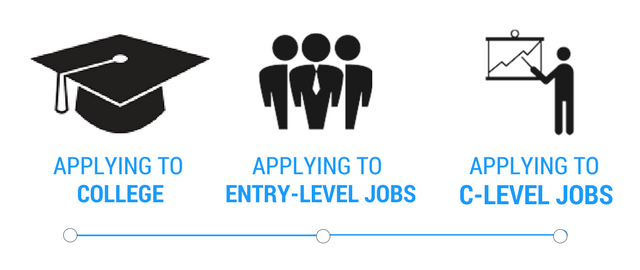
Anyone can say anything about you online without getting in trouble, whether it’s true or not. If you upset anyone - an ex, a fired employee, someone you received a promotion over - they can go virtually anywhere online and trash you. It happens all the time and there are very little laws in place to protect people under these situations. For this reason, and more, risk factors can appear at any time to hurt your career.
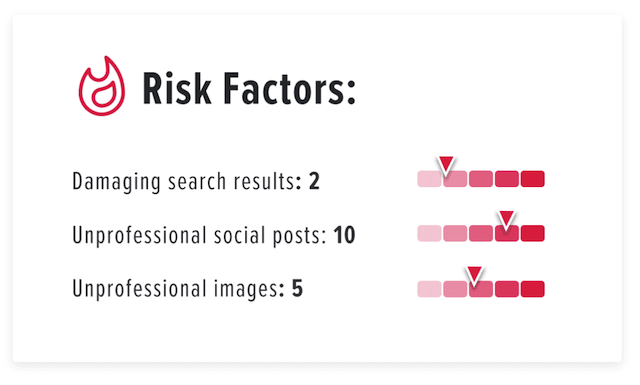
Everything we do online, from the things we post to social media, the sites we visit, the things we purchase, and even the conversations we send via text/messenger, is stored somewhere. This puts you more at risk for a reputational nightmare. Private information (like your email, address, age, relatives, and more) made public on data broker sites leave you susceptible to hackers, identity thieves, telemarketers, and more. We need more tools to safeguard our privacy.
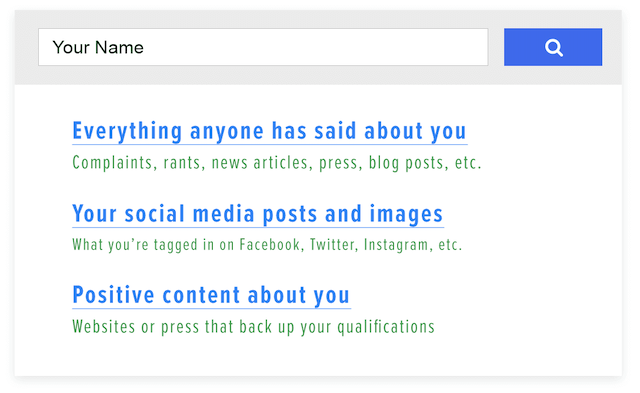
Building a positive personal brand online gives you an edge, but most don’t know how to create one. A positive online presence can help you stand out in an increasingly competitive economy. Learning how to establish a winning personal brand can advance one’s career.

How to diagnose & clean up your current digital footprint
The first step to controlling any situation is determining whether or not you have a problem and, if so, how bad the problem really is. In the first part of this guide, we'll help you diagnose your Google ranking (what shows up in the search results for your name and in what order they appear), audit your presence on social media, and take you through how to begin cleaning up your online reputation.
Which Google Ranking Category Are You?
The very first thing you need to do is go to Google and type your name into the search bar.
Once you have your search results in front of you, it's time to figure out which category your Google rank and overall online reputation falls under. Decide which of these categories best represents your first page of search results for your name (it may even be a combination of them all!) Tip: Concentrate on the first page of your Google results - 93% of searchers never go past the first page and use the first 10 search results to form their impression.
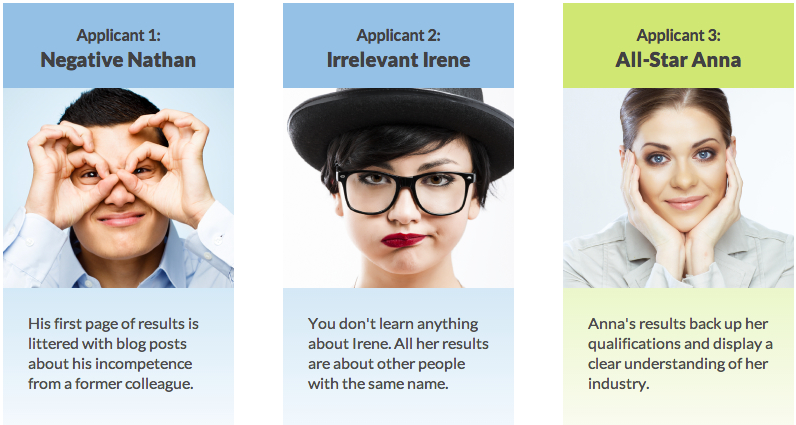
If you find yourself with little to no positive content about you on the first page of Google results, you're not alone. In a study of BrandYourself users, we found that 1 in 4 people have no positive content about them on the first page of Google and only half of people own the first spot. We broke out more of what this study found in a handy infographic:

Once you know where you stand, you can make an online reputation management plan:
- I Have No Web Presence, and No Content: The first thing you need to do is build your online presence for Google. Quite simply, if you don't have any positive content, there is no way for it to show up on your first page.
- I Have Specific Content I Want to BURY: Perhaps you have something unflattering out there about you, or you're being mistaken for an ex-con of the same name. The plan here is to create content that buries the negative result(s) farther down..
- I Have Specific Content I Want to Push Higher: You might already have a personal website, a LinkedIn profile, an article written about you or other content you want people to find, but they just aren't showing up high in search results. There are specific steps you can take to boost them higher in Google search results for your name.
Scan & Clean Up Risky Social Media Posts
Do an audit of your social media accounts and delete old posts/photos that may be inappropriate. This includes obvious things like posts that reference sex, drugs, bigotry, sexism, etc. as well as polarizing topics like religion or politics that may not seem bad, but could damage your reputation if seen by the wrong person or taken out of context. More and more HR departments are required to use social media as a candidate screening tool, both to look for red flags as well as reinforcing the candidate as a good cultural fit.

How SEO plays a part in your online brand
Search Engine Optimization (SEO) is the process of creating or improving content to make sure it shows up as high as possible in web search results for the right keywords (in the case of personal SEO, Your Name). It’s a fundamental aspect of online reputation management no matter what your specific goals are.
SEO Basics: What to know
Search engines employ algorithms with hundreds of factors to determine how to rank results. However, there are a few main factors you should always keep in mind when it comes to search engine reputation management:
On Page SEO Factors:
These are factors within the actual page. Search engines, like Google, have bots or “spiders” that crawl the web and look for these factors on webpages when deciding where to rank them. The good news is, if you own the content, you have direct control over these:
- Keyword/Content: When a search engine visits your page, it needs to quickly understand which words and phrases are the most important—what we call keywords. When it comes to your personal online reputation management, the keyword is “Your Name”. This means your name should be in key places throughout the site.
- Frontend & Backend Structure/Architecture: How your website is set up is key to how it communicates to search engines & ranks for your name. Fortunately, most templates provided by website builders (which we will get into below) are already structured in a search-engine friendly way.
- Relevancy: This one is simple—keep your content updated. If your content hasn't been updated in a long time, search engines start to view it as irrelevant.

Off Page SEO Factors:
These factors aren't directly tied to the content on your page and are meant to gauge the page's outside credibility. Since you can't directly control these factors, it's important you dedicate time to the most important ones:
- Incoming Links: Search engines consider each link to a site as a "vote" for that site to show up higher. The more places that link to your site, the higher search engines will rank it. However, the credibility of the link is also important. For example, a link from CNN.com is weighted more heavily then a link from a random no-name site.
- Social Sharing: Sharing a page across social networks is one of the easiest ways to build credible links. If you share a relevant, valuable page, people will pass it around, signaling a great deal of credibility to search engines.

The difference between SEO & online reputation management
While SEO focuses on a specific strategy of improving the search rankings of a webpage, online reputation management looks at the big picture of your online presence. It takes into account all of the search results for your name and how you come across to others who are looking you up.
A 4-Step online reputation management strategy for improving your search results
Now it's time to actually start building the foundation of your Google presence. The idea behind this part is simple: you can't make your google results look better if you don't have any good content in the first place. So let's get the basics in place.
Step 1: Purchase Your Domain (yourname.com)
Purchasing your domain name is quite possibly the most important step you can take if you want to show up on the first page of Google. It's roughly a $10/year investment and incredibly easy. You can buy your domain at any number of registrars such as hover.com or GoDaddy.

- Not all domains are created equal: While this isn't quite as important as it used to be, there are certain top-level domain-types that search engines tend to rank higher. For a personal domain, try to stick to a .com or a .net. Avoid some of the newly popular domain-types like .me or .tv since they don't usually rank as well.
- Make sure your name is included exactly as is: For example let's say your professional name is Pete Kistler. If PeteKistler.com is taken, it's much better to buy PeteKistler.net or PeteKistlerOnline.com, than to alter your name slightly and buy PeterKistler.com, or PeterLKistler.com.
Step 2: Build a Personal Website
Now that you have your domain, it's time to build a personal hub on the web where you can display everything from your work history to your personal interests. Today, anybody can create their own personal website, without having any technical knowledge. This is an extremely powerful tool for practicing effective search engine reputation management. There are a lot of options out there like Wordpress, Wix, and Squarespace. They’re easy to get set up, but also allows for a lot of customizing as you develop your personal identity online and get more comfortable (or if you're interested in tweaking your design, etc.).

Key components for your website:
- About Page: This is your chance to fill your site with all the information you'd want someone to know about you. Include your personal bio, education, your work experience and your personal interests. If you have any examples of your work, upload them here. This is the page that lets search engines know there is a lot of relevant information about Your Name.
- Blog: Blogging serves two functions that help your site show up higher. First, it's another easy way to keep your site updated and relevant (more on this below). Second, every post you write is a potential result that can show up on your first page. The more content you create and share, the more chances you have to be indexed, linked to, and of course, ranked by search engines.
- Contact Page: Include the best way for someone to contact you and other places they can find you online (like your professional profiles).
Step 3: Get on Social Networks
Search engines tend to rank social media profiles like Facebook, Twitter, and LinkedIn high, and for good reason: They require some sort of authentication to create, so search engines view them as more credible. Also important, they are constantly updating, making them extremely relevant due to their "timely" content (which we covered in SEO basics). In short, if you're trying to show up higher in Google, creating professional social media profiles is essential.

- Keep it clean or keep it private: Before you start promoting a social network, it's important to remember that everything you post is public and can be seen by everyone.
- Make sure you use your actual name: If you want your Twitter profile, or any other social profile for that matter, to show up high for your name, make sure your username is petekistler or Pete_Kistler, not Chilldude33. Tip: If your username is already taken, simply use some variation that still includes your full name, like PRPeteKistler or Pete_Kistler.
- Link to all your other content: Make sure you include a link back to your website and as many other profiles as they'll let you include, as we mentioned before links are a very important factor in search engine rankings. The more credible pages your site links to about you (and vice versa), the higher it will rank for your name.
Step 4: Create ongoing content to establish a personal brand
This is one of the most important steps for a long-term online reputation management strategy. It keeps your websites/professional profiles relevant while also helping to enhance your brand.

- Stay active on social media: Engagement on social media is incredibly important. Connecting with others within your industry is a good place to start. Share your own posts/updates as well as like/comment on others.
- Blog at least once per month: You don’t have to be a professional writer to actively blog. Keep the topics in line with the type of personal brand you’re trying to build. Blog about industry trends, your interests, things your potential clients/customers would find interesting, etc.
- Create and share rich media: Images, video, and other forms of rich media rank very well in search results. SlideShare is an excellent resource for creating interactive & embeddable presentations. Share these on social media and embed in your blog posts where you can. If you’re stuck, look to use content that you’ve already created for work or other projects.
Options for dealing with negative or unwanted search results
All it takes is one bad blog post or status update from an upset ex, one disgruntled former client or employee, or one photo tagged in bad judgement after a night out with a friend to ruin your online reputation. The point is, bad results can happen to good people, and this guide is meant to walk you through the emergency tactics you can use to salvage your reputation.
Option 1: Get it Taken Down
One common misconception about online reputation management is that information cannot be removed from the web. While this is true in most cases, there are certain situations where removal is possible:
- Ask to have it removed: Find the source of the person who posted the content (article author, social media account owner, website owner, etc.) and approach them about having it taken down. If you approach the owner professionally and explain why you need the content to be taken down, they may oblige. Chances are there's a reason the other person put it up in the first place, and they have no intention of removing it. If you do decide to take legal action, it can prove to be a long, drawn-out process that is difficult to undertake.
- Submit a legal complaint to Google It is very difficult to have Google remove content directly from its search results, but it can be done. If the content is defamatory or contains personal information such as your social security number or credit card information, you can file the legal complaint. Here’s a video from Google explaining the situations where removal is an option:
- File a DMCA Takedown: The Digital Millennium Copyright Act (DMCA) protects copyrighted information and prevents websites as well as search results from displaying copyrighted material without permission. You can file a request to the hosting site as well as Google. This can be an effective strategy but there needs to be an actual copyright violation and you need to be able to prove it.
- Online defamation court order: As mentioned above, you can submit a court order to Google as well as a website if a judge deems the content defamatory. This has limited effectiveness given the first amendment and requires going to court and having them rule in your favor - this can be incredibly expensive and time-consuming.
- “Right to be Forgotten”: This ruling in the EU requires Google to review requests for info to be removed from their search engines that may be “inaccurate, inadequate, irrelevant, or excessive” This is only effective for EU citizens and even then the process is tedious, with requests being rejected more often than not.
- Non-consensual pornography (revenge porn): Revenge porn is an increasing problem on the Internet that typically occurs in the aftermath of a break up where one partner shares intimate photos of the other in an act of revenge. Many sites are developing procedures to remove revenge via their Terms of Service and will have specific instructions to take on their site. Unfortunately, the laws surrounding revenge porn are moving slowly.
- Miscellaneous Terms of Services: Some sites (like legal and news aggregators) will take down items when provided with the proper documentation. Not every site follows these guidelines though.
Here’s a great breakdown of the type of removal options, including which situations that are applicable and the likelihood of success:
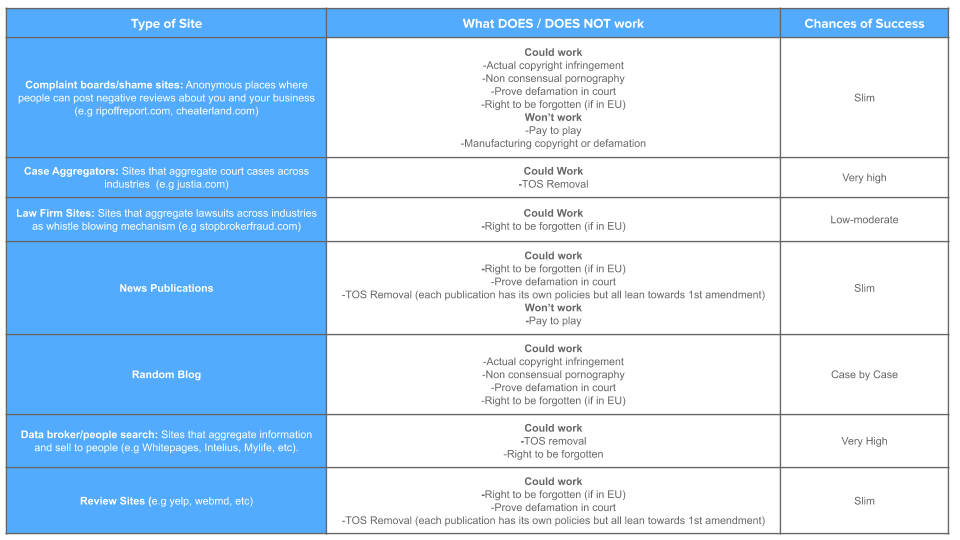
Option 2: Bury It
This exemplifies the main concept of this guide: build and maintain positive content so that it buries anything unwanted farther down the search results. While this doesn't technically remove it from search engines, it does drastically decrease the chances someone searching for you finds it. Since 93% of people don’t go past the first page of search results, your goal is to suppress the content to the second or third page. Considering there are about 10 results per page, you need to control at least 10-12 sites and profiles to have a chance at owning the first page of your results.
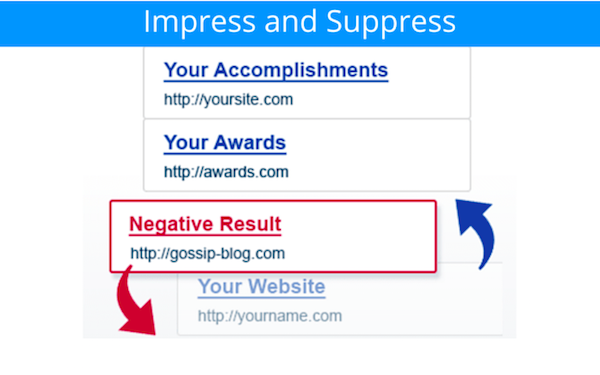
Case Study: Suppressing a negative search result
So what does this process actually look like? Take Client A for example:
- The situation: After 15 years of experience in the financial industry, a few negative news articles on authoritative sources started defining his brand.
- The solution: Build a series of branded, well-optimized properties that were consistently updated with unique content. Over time, he was able to take control of 90% of the first page of search results and push the damaging results to page 2 and beyond.
Request the free case study for the full action plan.
How to pick a reputation management company
If you don’t have the time to handle the work yourself, or you’re dealing with a particularly difficult situation, then it may be time to bring in the experts. Selecting the right firm to work with is an incredibly important decision and will dictate the overall success. We’ve written extensively on th
reputation management industry, but here are a couple of things to look out for:
- Research the size and credibility of the company you choose to work with: They should be able to point to real work, with real clients that you can look up yourself in Google. Also, ask to speak with or meet members of the team that would be working on the campaign. If they’re unable to do so, it’s likely a red flag that the work is outsourced and low quality.
- Ask specifically about what they are going to do to help your problem: There is no magic bullet when it comes to creating content on the first page of search results. It’s everything we outline in this guide! You need online properties that are optimized to rank well in Google and that are frequently updated with high-quality content over time. Be careful of companies that mystify the process or claim to have an overnight fix.
- Flexible payment options: Some companies will insist on an up-front payment or provide payment plans over just the few months. This is risky because they’ve collected their entire fee before your problem is solved. Push to ask about a monthly option.
- Be cautious about guarantees related to removals: As we highlighted above, removing something from search results is only possible in limited situations. Many companies will guarantee they can remove sites, even when it is not possible and use it as an opportunity to upsell you later (or they may be using the pay to play technique we outlined above, which should be avoided).
Final Thoughts
Plain and simple, online reputation management matters. Whether you’re dealing with unwanted search results or looking to improve your personal brand, it’s crucial that you’re actively maintaining a positive online presence.
Not sure where to start? BrandYourself offers a DIY tool as well as custom online reputation management services to help you monitor, clean up, improve, and protect your online presence. Get started with our free DIY tool, give us a call at (646) 863-8282, or schedule a free consultation to begin taking control of your online reputation today.



